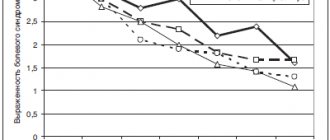Directions for use and doses
Children aged 6 to 12 years: 1/2 tablet 2-3 times a day.
Adults and children over 12 years of age: 1 tablet 3 times a day for the first 2-3 days. Continue treatment with 1 tablet 2 times a day.
If necessary, the therapeutic effect for adults and children over 12 years of age can be enhanced by taking 2 tablets 2 times a day.
The tablets should be swallowed whole with plenty of liquid (such as water, tea or fruit juice) with or without food.
Lazolvan® tablets should not be used for longer than 4-5 days without consulting a doctor.
Tablets 30 mg
Use in children
According to the instructions, Lazolvan® cough tablets are intended for adults and children over 6 years of age. Such age restrictions are associated with the dosage form and dosage of the active substance, which contains 30 mg in one tablet. Children under 6 years of age need less than 30 mg of the drug at a time, and it is easier for them to drink a solution or syrup than to swallow a tablet. 1 ml of solution contains 7.5 mg of active substance, which is 4 times less than in a tablet. The active ingredient in syrup is 15 mg/5 ml.1
During lactation
Taking Lazolvan® tablets during lactation is contraindicated. Its active ingredient ambroxol hydrochloride can pass into breast milk, the baby will receive a dose of the drug that he does not currently need.1
Use during pregnancy
Lazolvan® tablets are not recommended for use in the first trimester of pregnancy. Ambroxol penetrates the placental barrier, although preclinical studies have not revealed direct or indirect adverse effects on pregnancy; precautions must be taken during this period.1 This is the time when the body of the unborn child is forming and most medications are not recommended for use during this period.3
In the second and third trimester of pregnancy, it is recommended to prescribe Lazolvan® tablets only if treatment of the mother is more important than the potential risks to the fetus.1
For impaired renal function
For kidney diseases and disorders of their function, including failure, Lazolvan® tablets are used only as prescribed by a healthcare professional.
The fact is that any kidney disease, and especially renal failure, significantly changes the processes of renal filtration and distribution of drugs, purification of blood, lymph, and intercellular fluid from them. Kidney disease also affects the binding of drugs to plasma proteins, from where they are distributed to organs. Such changes may require monitoring by a healthcare professional to monitor the body's response, adjusting dosages and/or frequency of dosing.2, 3
For liver dysfunction
Liver diseases and liver failure can affect its important functions: detoxification, cleansing, metabolic.
In case of liver failure, Lazolvan® tablets should be used with caution.1, 3
Active substance
Ambroxol hydrochloride 30 mg is the active ingredient in Lazolvan® tablets. One tablet contains 30 mg of ambroxol.
It is a mucolytic, expectorant, and thins mucus. Increases secretion in the respiratory tract. Increasing mucociliary clearance improves sputum discharge and relieves cough. In patients with COPD, there was a significant reduction in the duration of exacerbations and the number of days of antibiotic therapy.1
Advantages
Protective properties of ambroxol:
- Reduces inflammation.
- Has an antioxidant effect and enhances lung protection.
- Liquefies mucus and makes it easier to expectorate.
- Increases the concentration of antibiotics in lung tissues.
- Increases the formation of surfactant in the lungs, a special substance that helps “wash away” mucus from the walls of the bronchi and its further removal.
Expectorants can thin thick mucus, clear mucus from the airways, and protect lung tissue.
Ambroxol is an expectorant with a triple effect: it facilitates the thinning of mucus, its elimination and enhances lung protection.
Ambroxol is a remedy for treating cough in children and adults. It has proven effectiveness and a favorable safety profile. A large selection of release forms will help you choose individual treatment for each family member.
special instructions
Use during pregnancy or breastfeeding
Pregnancy. As a result of clinical studies of the use of the drug after the 28th week of pregnancy, no harmful effects on the fetus were revealed.
Lactation. Lazolvan® is not recommended for use during breastfeeding.
Children
For use in children over 6 years of age who cannot tolerate syrup or solution for inhalation and oral administration.
Product description certified by the manufacturer Boehringer Ingelheim
.
Verified by
Likar Turumkulova Irina
Lazolvan 30 mg 50 pcs. pills
pharmachologic effect
Mucolytic and expectorant drug.
Composition and release form Lazolvan 30 mg 50 pcs. pills
Tablets - 1 tablet:
- Active ingredients: ambroxol hydrochloride - 30 mg;
- Excipients: lactose monohydrate - 171 mg, dried corn starch - 36 mg, colloidal silicon dioxide - 1.8 mg, magnesium stearate - 1.2 mg.
10 pieces. - blisters (2, 5) - cardboard packs.
Description of the dosage form
The tablets are white or slightly yellow, round, flat on both sides, with beveled edges, on one side there is a score line and the engraving “67C”, embossed on both sides of the score line, on the other side of the tablet is the company symbol.
Directions for use and doses
The drug is prescribed orally at 30 mg (1 tablet) 3 times a day. If necessary, to enhance the therapeutic effect, you can prescribe 60 mg (2 tablets) 2 times a day.
The tablets are taken with liquid. You can take the tablets regardless of meals.
If symptoms of the disease persist within 4-5 days from the start of treatment, it is recommended to consult a doctor.
Pharmacodynamics
Mucolytic and expectorant drug.
Studies have shown that ambroxol increases secretion in the respiratory tract. It enhances the production of pulmonary surfactant and stimulates ciliary activity. These effects lead to increased mucus flow and transport (mucociliary clearance). Increasing mucociliary clearance improves sputum discharge and relieves cough.
In patients with COPD, long-term therapy with Lazolvan® (for at least 2 months) led to a significant reduction in the number of exacerbations. There was a significant decrease in the duration of exacerbations and the number of days of antibiotic therapy.
Pharmacokinetics
Suction and distribution
All dosage forms of immediate release ambroxol are characterized by rapid and almost complete absorption with a linear dose dependence in the therapeutic concentration range. Cmax in plasma is achieved after 1-2.5 hours. The absolute bioavailability of Lazolvan® 30 mg tablets is 79%.
Vd is 552 l. In the therapeutic concentration range, binding to plasma proteins is approximately 90%. The transition of ambroxol from the blood to tissues when administered orally occurs quickly. The highest concentrations of the active component of the drug are observed in the lungs.
Metabolism and excretion
Approximately 30% of an administered oral dose undergoes first-pass effects through the liver. Studies in human liver microsomes have shown that CYP3A4 is the predominant isoform responsible for the metabolism of ambroxol to dibromoantranilic acid. The remainder of ambroxol is metabolized in the liver, mainly by glucuronidation and by partial breakdown to dibromanthranilic acid (approximately 10% of the administered dose), as well as a small number of additional metabolites.
The terminal half-life of ambroxol is about 10 hours. The total clearance is within 660 ml/min, renal clearance accounts for approximately 83% of the total clearance.
No clinically significant effect of age and gender on the pharmacokinetics of ambroxol was found, so there is no basis for selecting the dose based on these characteristics.
Indications for use Lazolvan 30 mg 50 pcs. pills
Acute and chronic diseases of the respiratory tract, accompanied by the release of viscous sputum:
- acute and chronic bronchitis;
- pneumonia;
- COPD;
- bronchial asthma with difficulty in sputum discharge;
- bronchiectasis.
Contraindications
- I trimester of pregnancy;
- lactation period;
- children and adolescents up to 18 years of age;
- lactase deficiency, lactose intolerance, glucose-galactose malabsorption;
- hypersensitivity to ambroxol or other components of the drug.
The drug should be prescribed with caution in the second and third trimesters of pregnancy, in case of renal and/or liver failure.
Application of Lazolvan 30 mg 50 pcs. pills during pregnancy and breastfeeding
Ambroxol penetrates the placental barrier.
Preclinical studies have not revealed direct or indirect adverse effects on pregnancy, embryonic/fetal, postnatal development and labor.
Extensive clinical experience with the use of ambroxol after the 28th week of pregnancy has not found evidence of a negative effect of the drug on the fetus.
However, normal precautions must be taken when using the medicine during pregnancy. It is especially not recommended to take Lazolvan® in the first trimester of pregnancy. In the second and third trimesters of pregnancy, the use of the drug is possible only if the expected benefit to the mother outweighs the potential risk to the fetus.
Ambroxol can be excreted in breast milk. Despite the fact that no undesirable effects were observed in breast-fed children, it is not recommended to use Lazolvan® during lactation.
Preclinical studies of ambroxol did not reveal any negative effects on fertility.
Contraindicated for use in children and adolescents under 18 years of age.
special instructions
Should not be used in combination with antitussives that impede the removal of sputum.
One tablet contains 162.5 mg of lactose. The maximum daily dose (4 tablets) contains 650 mg of lactose.
In patients with severe skin lesions (Stevens-Johnson syndrome or toxic epidermal necrolysis), fever, body pain, rhinitis, cough and sore throat may appear in the early phase. During symptomatic treatment, it is possible to erroneously prescribe mucolytic drugs such as ambroxol. There are isolated reports of the detection of Stevens-Johnson syndrome and toxic epidermal necrolysis, which coincided with the administration of the drug; however, there is no causal relationship with the drug. If the above syndromes develop, it is recommended to stop treatment and immediately seek medical help.
If renal function is impaired, Lazolvan® should be used only on the recommendation of a doctor.
For children and adolescents under the age of 18, it is possible to use other dosage forms of Lazolvan (syrup, lozenges, solution for oral administration and inhalation).
Impact on the ability to drive vehicles and operate machinery
There were no cases of the drug affecting the ability to drive vehicles and machinery. Studies on the effect of the drug on the ability to drive vehicles and engage in other potentially hazardous activities that require increased concentration and speed of psychomotor reactions have not been conducted.
Overdose
Specific symptoms of overdose in humans have not been described.
There have been reports of accidental overdose and/or medical error resulting in symptoms of known side effects of Lazolvan®: nausea, dyspepsia, vomiting, abdominal pain.
Treatment: artificial vomiting, gastric lavage in the first 1-2 hours after taking the drug; symptomatic therapy.
Side effects Lazolvan 30 mg 50 pcs. pills
From the digestive system: often (1-10%) - nausea; infrequently (0.1-1%) - dyspepsia, vomiting, diarrhea, abdominal pain.
From the immune system, from the skin and subcutaneous tissues: rarely (0.01-0.1%) - rash, urticaria; angioedema*, anaphylactic reactions (including anaphylactic shock)*, itching*, hypersensitivity.
* these adverse reactions were observed with widespread use of the drug; with a 95% probability, the frequency of these adverse reactions is uncommon (0.1%-1%), but possibly lower; the exact frequency is difficult to estimate, because they were not noted in clinical studies.
Drug interactions
No clinically significant adverse interactions with other drugs have been reported.
Ambroxol increases the penetration of amoxicillin, cefuroxime, and erythromycin into the bronchial secretions.
Note!
Description of the drug Lazolvan table. 30mg No. 50 on this page is a simplified author’s version of the apteka911 website, created on the basis of the instructions for use.
Before purchasing or using the drug, you should consult your doctor and read the manufacturer's original instructions (attached to each package of the drug). Information about the drug is provided for informational purposes only and should not be used as a guide to self-medication. Only a doctor can decide to prescribe the drug, as well as determine the dose and methods of its use.


